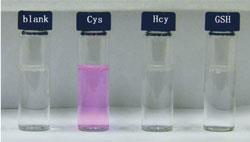A way to monitor cysteine levels in the blood, high levels of which are linked with neurological diseases
A highly selective indicator for the amino acid cysteine has been designed by scientists from the US and China to monitor levels in human plasma. Elevated cysteine levels have been linked with motor neurone disease, Parkinson’s disease and Alzheimer’s disease.
Cysteine is an essential amino acid and plays an important role in cell functions. Its structure contains both a sulfhydryl (-SH) and an amino group (-NH2), both of which are reactive. Previous detectors have focused on reactions with the sulfhydryl group, but it has been tricky to detect cysteine over other SH-containing biomolecules in the blood, such as glutathione and the closely related homocysteine.

Robert Strongin from Portland State University, Portland, and co-workers, have found a way to overcome this problem, by designing a fluorescent sensor called a chemodosimeter (so called because the visible change is due to an irreversible reaction). They used an indicator molecule that reacts with both the sulfhydryl and amino parts of the cysteine molecule.
’We can detect cysteine selectively due to its unique chemistry, which we have complemented with our indicator design,’ explains Strongin. ’There is a very selective reaction that turns the indicator on.’ The cysteine’s sulfhydryl group reacts with the indicator molecule to form a colourless compound. The amino part attacks an ester group on the indicator molecule to form a pink compound that is fluorescent under UV light. When tested with other amino acids or SH-containing molecules, no colour change or fluorescence could be seen.
’Compared to designing probes for the detection of metal ions or inorganic anions, analytes such as cysteine tend to be far more problematic. The work provides convincing evidence that a clever design can overcome such obstacles,’ says Michael Heagy, an expert in fluorescent chemosensors for biological molecules at the New Mexico Institute of Mining and Technology, US.
In the future, Strongin plans to develop the approach to make other specialised indicators for non-polar metabolites, such as amino acids, sugars and phospholipids.
Helen Potter
References
Org. Biomol. Chem., 2012, DOI: 10.1039/ <man>c2ob25178g</man>






No comments yet